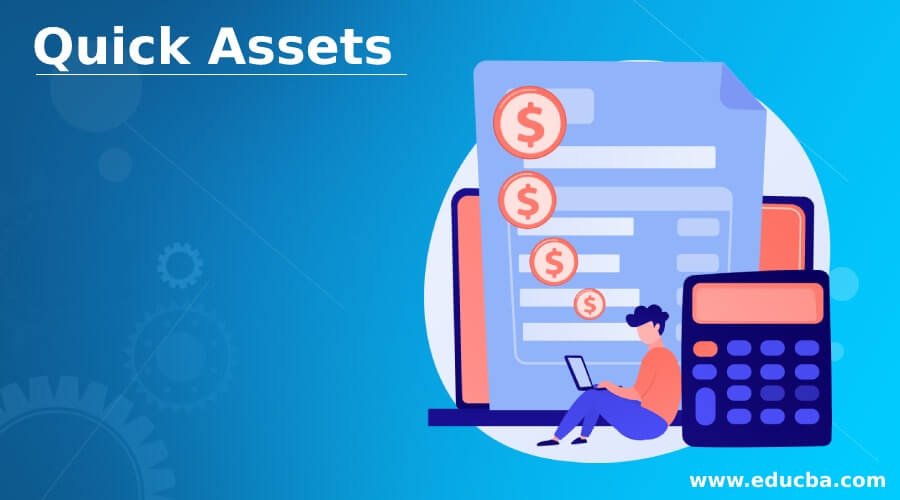Updated July 17, 2023

Definition of Quick Assets
Quick assets are those owned by the company that can be easily and quickly converted into cash. They help meet the company’s short-term liabilities as and when they are due.
They are the most liquid assets in the business and include cash and cash equivalents, marketable securities, and accounts receivable. Quick assets use for calculating various financial ratios by organizations that vouch for their financial health and working capital.
Explanation
Assets can easily and quickly convert into cash without incurring high costs for their conversion and are accounted for as quick assets. The period they can convert into cash in less than a year.
Quick assets generally do not include inventory because converting inventory into cash takes time. Though there are ways in which businesses can quickly convert inventory into cash by providing steep discounts, this would result in high costs for the conversion or loss of value of the asset. Similarly, pre-paid expenses are also excluded from the calculation of quick assets since their adjustment takes time and they are not convertible in cash. Companies use quick assets, such as cash and short-term investments, to meet their operating, investing, and financing requirements.
How to Calculate Quick Assets?
Quick assets form part of the current assets, and current assets include inventories as well. Therefore, to calculate the quick asset, inventory must exclude or deduct from the value of the current assets.
Where,
Examples of Quick Assets
Let’s take an example to understand the calculation of Quick Assets in a better manner.
Example #1
ABC company’s balance sheet provides the following data. Let us see how we can calculate the value of quick assets.
Solution:
Quick Assets calculates using the formula given below
- Quick Assets = (Account Receivable + Cash + Short-Term Marketable investments)
- Quick Assets = ($200,000 + $150,000 + $400,000)
- Quick Assets = $750,000
Remember, inventory does not form part of quick assets.
Example #2
A company’s balance sheet provides the following information: we need to calculate the value of quick assets.
- Current assets: $200,000
- Inventory: $40,000
- Pre-paid expenses: $10,000
Solution:
Quick Assets calculates using the formula given below
- Quick Assets = Current assets – Inventories – Pre-Paid Expenses
- Quick Assets = ($200,000 – $40,000 – $10,000)
- Quick Assets = $150,000
Thus, the value of quick assets can derive directly from reducing the value of inventory and pre-paid expenses from the current assets.
List of Quick Assets
The following assets consider as most liquid assets or Quick Assets:
- Cash: Cash held by the company at the bank or other interest-bearing accounts like fixed or recurring deposits.
- Accounts Receivable: Amount due to receive from customers against the goods and services supplied.
- Marketable Securities: Investment securities that can easily trade in the secondary market and convert into cash at the quoted price.
- Short-Term Investments: Stock, bonds, and other securities investments are expected to be realized in a year and are liquid.
Difference Between Quick Assets and Current Assets
The difference between quick assets and current assets can well understand from the following table:
| Quick Assets | Current Assets |
| Quick assets don’t include inventory prepaid expenses as they cannot be converted into cash easily. | Current assets include inventory, prepaid expenses, and other liquid assets. |
| Quick assets are not shown as a separate head in the statement of financial position. | Current assets are shown as a separate head in the statement of financial position. |
| Liquid or quick assets help calculate the company’s quick ratio. | Current assets help in calculating the current ratio for the company. |
| In the practical world, liquid or quick assets are considered the most liquid assets and can be quickly converted into cash compared to current assets. | In the practical world, current assets are considered less liquid than quick assets as it takes time to convert a few components of current assets into cash. |
Advantages
Quick assets are advantageous in the following ways:
- They are highly liquid, therefore, are very helpful in meeting the short-term liabilities of the organization.
- They serve as a source of financing for buying out new investments without relying on other lines of credit.
- They carry lower risk in comparison to non-liquid assets.
- They represent the business’s strong financial health, which helps investors decide to invest in the business.
Disadvantages
There are some limitations concerned with quick assets:
- Holding too many quick assets will lead to a loss of opportunity cost as these assets do not earn much interest. Sometimes, they do not pay any interest.
- A high level of quick assets means that the business is risk-averse and is not investing in new ventures, which could create a negative reputation in the investor’s eyes.
- Holding too many liquid assets also leads to tax liability, as liquid assets are taxed differently than non-liquid assets to promote investments.
Conclusion
Quick assets are integral to a company’s liquidity and indicate short-term financial health. Companies maintain quick assets per the requirement and industry in which they operate. Business managers should balance holding an appropriate level of quick assets to avoid sacrificing much on opportunity cost.
Recommended Articles
This is a guide to Quick Assets. Here we discuss how to calculate Quick Assets along with practical examples. You may also look at the following articles to learn more –

